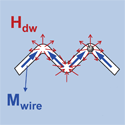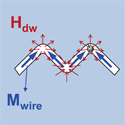Magnetic joystick
Magnetic particles can be guided with external fields through small-scale fluidic environments, bringing with them a biological molecule hitching a ride. A paper appearing in Physical Review Letters presents a two-dimensional magnetic trap that uses this type of magnetic remote control to guide the thermal motion of submicron magnetic beads.
Following a magnetic trap design from their earlier work, Aaron Chen at The Ohio State University in Columbus and his colleagues deposit a -micron-wide magnetic wire in the shape of a zigzag on a silicon surface. Chen et al. apply a one-time, large, in-plane magnetic field of oersted to polarize the legs of the zigzag shape, resulting in a sequence of head-to-head and tail-to-tail magnetic domain walls which meet at the kinks in the wire. Embedding the trap in a solution of magnetic beads, the team coaxes the beads to the large magnetic trapping gradients near the kinks using fairly weak (less than 100 oersted) external magnetic fields. The key control parameter is the strength of the external field perpendicular to the trap.
This setup allows exploration between two types of particle motion: one where the beads are tightly confined near a wire kink and another where the motion, driven by thermal fluctuations, spreads out around the kink. A magnetic trap such as this has the additional benefit that it does not rely on strong fields to move the particles or generate heat, both of which could perturb the environment studied. – Jessica Thomas





